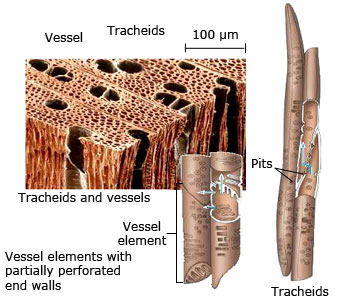 Water conducting cells of xylem
The xylem transports water and soluble mineral nutrients from the roots throughout the plant.
Water conducting cells of xylem
The xylem transports water and soluble mineral nutrients from the roots throughout the plant.
The mechanism of transport in multicellular higher plants is much more elaborate. Due to the branching shape of a plant, all the cells of a plant can get oxygen for respiration and carbon dioxide for photosynthesis directly from the air by diffusion. So, the only substances, which are to be supplied to a plant through a transport system are water and minerals (which they can't get from the air).
Another function of transport system of plants is to transport food prepared in the leaves to the various parts of the plants like stems, roots, etc. The process of diffusion, which is slow, cannot meet the requirements of transport to all parts in a short period of time. Hence some special tubes called xylem and phloem, which comprise the conducting tissues or vascular tissues pick up the essential substances like food, water, etc., at one end of their body and carry them to all other parts.
Xylem tissues carry water and minerals whereas phloem tissues carry the food prepared by the plants (Phloem also carries the hormones made by the plants in their root and shoot tips). Xylem tissue consists of tracheids, vessels and xylem parenchyma. The xylem vessels and tracheids together form long tubes that have a narrow diameter. Thus they function as capillaries (narrow tubes) to transport water and minerals. Xylem parenchyma consists of living parenchyma cells associated with xylem. These cells serve for the storage of food (sugars and starch), and also help in the lateral conduction of water and minerals. Phloem transports organic substances like sucrose across the plant body. Sieve tubes and companion cells are mainly involved in the transport of the materials.